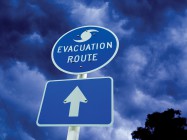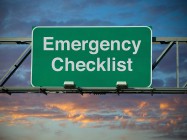Hurricane season in the US runs anywhere from May to November on both the east and west coast. In areas with a high likelihood of hurricanes it is important to prepare your home in the case of disaster. Follow these tips on preparing your house for a hurricane and for cleaning up afterwards.
How to Prepare Your Home for a Hurricane
Preparation
- Make a disaster relief kit filled with things like batteries, flashlights, first aid supplies, cash and copies of important documents in the event that you must evacuate. In the case of evacuation, know your local evacuation routes and have a plan for where you can stay. For more information contact your local emergency management agency.
- If you do not evacuate, supply your house with adequate food and water to last you for several days in case of power outages and road closures due to flooding.
- With the likelihood of high speed winds during a hurricane being high, trim or remove damaged trees and limbs to decrease the possibility of your property being damaged by flying debris.
- Inspect and secure your rain gutter and downspouts and clear any clogs that may exist to prevent water damage. Retrofit your roof, windows, doors and garage doors to reinforce and secure your home to further reduce chances of damage.
- If you are replacing your roof entirely, consider spending extra money on sealing your roof-deck and also make sure to add roof straps, which attach the roof to the walls using metals straps. If you aren’t replacing your roof, and if you can access your roof from the attic, you can add the metal roof straps to your home from there.
- If you have a porch or a car port connected to your house, ensure that the support posts for these structures are well attached to the ground. In the case of high speed winds, these structures may rip away from your house, leaving a large hole.
- Remove any free-standing objects from your lawn and store inside. This includes any object that could be picked up and thrown about in the instance of high winds like lawn furniture, grilling equipment and outdoor decorations.
- Consider investing in a portable generator or install a backup generator for power outages. If you chose to do this, it is important to remember to keep your alternate power source outside and at least 20 feet away from windows and doors, protected from moisture. Do not power your house by plugging the generator into a wall outlet.
- Invest in building a safe room in accordance with FEMA guidelines. This room is a hardened structure designed to provide the best protection for extreme weather conditions. When constructed properly, in accordance with FEMA guidance, these rooms give occupants a higher probability of protection from injury and death.
How to Clean-up After the Storm
- Limit your contact with any flood water as flood water may have high levels of sewage and other hazardous materials and bacteria. Do not turn on your well pump because of the danger of electric shock, instead get help from a well or pump contractor to aid in cleaning and disinfecting your pump before use. Once pump is turned on, pump the well until your water runs clean to ensure well is clear of flood water.
- To get rid of mold, you must control the moisture in your home. Do this by removing standing water in indoor areas, air drying your house by opening all doors and windows and using fans to dry out all other areas. Clean wet items using commercial cleaners and water, if you see mold, clean objects using a mix of bleach and water in an open, well-ventilated area. Fix leaks in roof, walls and plumbing as soon as possible. Any objects that you cannot dry or clean out within 48 hours, throw away.
- Do not bury or burn disaster debris like rubble, soil, tree and plant waster, and personal property without an approved waiver to limit the side effects associated with smoke and soil contamination from burial. Check your town’s disaster debris management plan to address issues of debris removal. If your town does not have a debris plan, you may want to bring up making one to local government officials, the EPA has guidance guidelines in place to help address making a plan.
For more tips, go to tips.acehardware.com
Published: 3/8/2020




